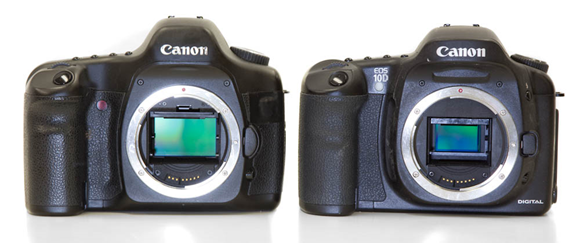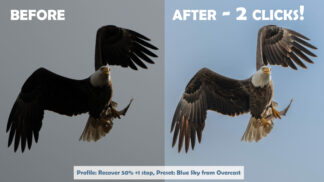Cameras can be divided into several categories by their sensor size. Starting with the smallest, they are:
- CX (2.7X). These tiny mirrorless cameras, such as the Nikon 1, have the smallest common sensors.
- Micro Four-Thirds (2X). These small mirrorless cameras have relatively small 16-megapixel sensors that are capable of producing excellent images when paired with the right lenses.
- APS-C (1.5X for most, 1.6X for Canon). The smallest type of DSLR is also a common mid-range mirrorless format and the right choice for most non-professional photographers. Lenses designed for their smaller sensors are lighter and less expensive than those designed for bigger, full-frame cameras. You can also connect full-frame lenses to Canon APS-C, Nikon DX, and Sony Alpha bodies, but when you take a picture, the camera will crop out a smaller section from the center of the lens image. This is known as the crop factor, and it’s actually helpful when using telephoto lenses with wildlife or sports. In fact, many wildlife photographers prefer an APS-C or DX camera over their full-frame counterparts. Crop factor is discussed in more detail later in this section.
- Full-frame 35mm (1X). Matching the sensor size of 35mm film, full-frame DSLRs require bigger, more expensive lenses. Full-frame DSLRs are the right choice for most professional photographers, but not simply because the sensor is bigger. Instead, I recommend full-frame cameras to photographers because they tend to have more features completely unrelated to the sensor. Additionally, full-frame Canon and Nikon cameras have access to the widest variety of native lenses simply because the formats have been used by professionals for decades. Given the same variety of native lenses, you could get the same photos with smaller sensors, but other formats simply don’t have the same variety available and adapting the lenses always comes with significant penalties.
- Medium format (less than 1X). Medium-format DSLRs provide professional studio photographers the resolution they need for shooting magazine covers and posters. The 60 megapixel Hasselblad H4D-60 retails for about $42,000, yet it can’t take decent indoor pictures without flash, it’s too slow for wildlife or sports, and it’s too big for most people to carry around (though I often travel with a medium format film camera). For those reasons, most professional photographers use full-frame 35mm DSLRs instead.
The following figure compares a compact camera sensor to a full-frame camera sensor.  The following figure shows the relative sizes of different sensor types along with the crop factor of each. The crop factor is very important to understand when purchasing lenses or even just reading this site.
The following figure shows the relative sizes of different sensor types along with the crop factor of each. The crop factor is very important to understand when purchasing lenses or even just reading this site. 
Crop Factor and Focal Length
Throughout this book and Stunning Digital Photography, I list focal lengths in 35mm equivalent. Therefore, if you want to calculate the equivalent focal length for a compact DSLR, you would divide the 35mm focal length by 1.6 for Canon or 1.5 for Nikon. If you want to calculate the equivalent focal length for a Micro Four-Thirds camera, you would divide the focal length by 2. If you want to calculate the equivalent focal length for a medium format camera, you would multiply it by 2. For example, a “normal” or “standard” lens sees about the same angle of view as our eyes. On a full-frame camera, the normal view is 50mm. On a compact camera, the normal view is about 31mm, or 50 / 1.6. On a Micro Four-Thirds camera, the normal view is about 25mm, or 50 / 2. Given this conversion, these three lenses provide similar zoom ranges when attached to the type of camera they were designed for:
- Micro Four-Thirds: the Olympus 14-42mm.
- Compact: the Canon 18-55mm.
- Full frame: The Sigma 24-105mm.
Most of the photography world, including myself, use 35mm equivalents when discussing focal length just because 35mm has historically been the most popular format. Therefore, if you see an example picture that shows a 200mm focal length, you can bet that it’s probably 200mm using the full-frame 35mm format. If you were using a compact DSLR and wanted the same field of view, you would use a 125mm lens, because 200 / 1.6 = 125. Tip: Big and small sensors can both have very high megapixel counts. However, smaller sensors capture less light because they have less surface area. So, the larger full-frame format will always be better in low-light and produce less noise—but the difference might never be important to you.
Crop Factor and Aperture
Different sensor sizes change the field of view provided by a focal length. We refer to this as the “crop factor,” and it allows us to quickly determine that a 45mm micro four-thirds lens is equivalent to a 90mm full frame lens. While the crop factor works for determining the field of view, it does not work for determining the depth of field and background blur that you’ll get from any given lens. While camera manufacturers often provide a “35mm equivalent” when describing a lens, they don’t tell you that you won’t get the same background blur when using smaller lenses, which has led to many frustrated portrait photographers. For example, consider two portrait lenses that seem very similar:
- The full-frame Canon 85mm f/1.8 ($400)
- The Micro Four-Thirds Olympus 45mm f/1.8 ($400)
Knowing that you double the focal length of micro four-thirds lenses to determine the 35mm equivalent, the Olympus seems to compare favorably to the Canon. You might see portraits taken with the Canon 85mm f/1.8 (such as the following), and assume that you’d be able to achieve similar background blur.  The Olympus can’t achieve the same background blur, however, because you must apply the crop factor to the aperture to calculate depth-of-field (and thus background blur). In this example, the Olympus 45mm f/1.8 lens is equivalent to a full-frame 90mm f/3.6 lens when considering both field of view and background blur. You can also multiply the depth-of-field by the crop factor. Therefore, a micro four-thirds camera with a crop factor of 2x has about twice the depth-of-field (and thus half the background blur) of a full frame camera, even after you multiply the focal length by the crop factor. An APS-C sized DSLR has 1.5X to 1.6X more depth of field or 50-60% less background blur than a full frame camera. For calculating the shutter speed you’d need in any given lighting scenario, you wouldn’t need to multiply the aperture—the Olympus would still have the same shutter speed as a full-frame 90mm f/1.8 lens, or any f/1.8 lens, for that matter. However, for portrait work, lenses for smaller sensors have far less background blur. To achieve similar background blur to the Canon 85mm f/1.8, you would need a 45mm f/0.9 lens, and nothing like that is currently available. Currently, the best micro four-thirds autofocusing lens for achieving a nice background blur is the Olympus M Zuiko ED 75mm f/1.8 ($830). For calculating background blur, this lens is equivalent to a full-frame 150mm f/3.6 lens. Unfortunately, that doesn’t compare favorably to traditional 35mm portrait lenses. My budget full-frame portrait recommendation, the Tamron 70-200 f/2.8 ($750), is just as sharp, less expensive, offers much better background blur, and provides a very useful zoom range. There is one micro four-thirds lens that provides full-frame SLR like background blur in a portrait focal length, but it lacks autofocus, and autofocus is critical when working with short depth-of-field portraiture because people move too much to manually focus on the eye. The SLR Magic Noktor 50mm f/0.95 is equivalent to a full-frame 100mm f/1.9 and is $1,100. Let’s consider that lens on crop- and full-frame DSLRs. On a Nikon DSLR with a compact sensor, it becomes equivalent to a 105-300 f/4.2. On a Canon DSLR with a compact sensor, it becomes equivalent to a 112-320 f/4.5. Only on a full-frame body will you be able to achieve the full potential of the lens’ ability to blur the background. I don’t want you to feel bad about purchasing a Micro Four-Thirds or APS-C camera; they’re very capable cameras, and background blur is only one aspect of photography. Smaller sensors, and their large depth of field, actually show you much more of a scene, making them ideal for landscapes. There are also other ways to control background blur, including moving your subject farther from the background. For detailed information, refer to Chapters 4 and 6 of Stunning Digital Photography. I hope that highlighting this weakness of smaller sensor designs for portrait work will help push lens manufacturers to offer faster lenses for the smaller sensors. The first manufacturer to give fair treatment to APS-C sized sensors is Sigma, with the Sigma 18-35mm f1.8 lens. When calculating background blur, this lens is roughly equivalent to a 27-52mm f/2.8 lens. It’s still too wide angle to make a viable portrait lens, but it’s an amazing lens for general photography with compact sensors, and I’m glad to see Sigma manufacturing faster lenses for smaller sensors.
The Olympus can’t achieve the same background blur, however, because you must apply the crop factor to the aperture to calculate depth-of-field (and thus background blur). In this example, the Olympus 45mm f/1.8 lens is equivalent to a full-frame 90mm f/3.6 lens when considering both field of view and background blur. You can also multiply the depth-of-field by the crop factor. Therefore, a micro four-thirds camera with a crop factor of 2x has about twice the depth-of-field (and thus half the background blur) of a full frame camera, even after you multiply the focal length by the crop factor. An APS-C sized DSLR has 1.5X to 1.6X more depth of field or 50-60% less background blur than a full frame camera. For calculating the shutter speed you’d need in any given lighting scenario, you wouldn’t need to multiply the aperture—the Olympus would still have the same shutter speed as a full-frame 90mm f/1.8 lens, or any f/1.8 lens, for that matter. However, for portrait work, lenses for smaller sensors have far less background blur. To achieve similar background blur to the Canon 85mm f/1.8, you would need a 45mm f/0.9 lens, and nothing like that is currently available. Currently, the best micro four-thirds autofocusing lens for achieving a nice background blur is the Olympus M Zuiko ED 75mm f/1.8 ($830). For calculating background blur, this lens is equivalent to a full-frame 150mm f/3.6 lens. Unfortunately, that doesn’t compare favorably to traditional 35mm portrait lenses. My budget full-frame portrait recommendation, the Tamron 70-200 f/2.8 ($750), is just as sharp, less expensive, offers much better background blur, and provides a very useful zoom range. There is one micro four-thirds lens that provides full-frame SLR like background blur in a portrait focal length, but it lacks autofocus, and autofocus is critical when working with short depth-of-field portraiture because people move too much to manually focus on the eye. The SLR Magic Noktor 50mm f/0.95 is equivalent to a full-frame 100mm f/1.9 and is $1,100. Let’s consider that lens on crop- and full-frame DSLRs. On a Nikon DSLR with a compact sensor, it becomes equivalent to a 105-300 f/4.2. On a Canon DSLR with a compact sensor, it becomes equivalent to a 112-320 f/4.5. Only on a full-frame body will you be able to achieve the full potential of the lens’ ability to blur the background. I don’t want you to feel bad about purchasing a Micro Four-Thirds or APS-C camera; they’re very capable cameras, and background blur is only one aspect of photography. Smaller sensors, and their large depth of field, actually show you much more of a scene, making them ideal for landscapes. There are also other ways to control background blur, including moving your subject farther from the background. For detailed information, refer to Chapters 4 and 6 of Stunning Digital Photography. I hope that highlighting this weakness of smaller sensor designs for portrait work will help push lens manufacturers to offer faster lenses for the smaller sensors. The first manufacturer to give fair treatment to APS-C sized sensors is Sigma, with the Sigma 18-35mm f1.8 lens. When calculating background blur, this lens is roughly equivalent to a 27-52mm f/2.8 lens. It’s still too wide angle to make a viable portrait lens, but it’s an amazing lens for general photography with compact sensors, and I’m glad to see Sigma manufacturing faster lenses for smaller sensors.
Crop Factor and ISO
You can also use crop factor to estimate the total image noise different sensors will have at a specific ISO. Simply multiply the ISO of the smaller sensor by the crop factor twice:
Smaller Sensor ISO * Crop Factor * Crop Factor = Full Frame ISO
Or, to write it another way:
Small Sensor ISO * (Crop Factor)2 = Full Frame ISO
For example, you can expect ISO 200 on a Micro Four-Thirds camera (which has a 2x crop factor) to have similar total image noise as ISO 800 on a full frame camera, because 200 * 2 * 2 = 800. You can expect ISO 100 on a Nikon APS-C camera (which has a 1.5x crop factor) to have similar total image noise as ISO 225 on a full frame camera. The following table gives you estimates of the amount of total noise you can expect from different ISOs and different sensor sizes, given similar sensor technology. That last clause, “given similar sensor technology,” is very important, and I’ll discuss it further.
| Full-frame | APS-C (1.5X) | Canon APS-C (1.6X) | MFT (2x) | CX (2.7X) |
| 64 | ||||
| 100 | ||||
| 200 | ||||
| 225 | 100 | |||
| 256 | 114 | 100 | ||
| 400 | 178 | 156 | ||
| 640 | 284 | 250 | 160 | |
| 729 | 324 | 285 | 182 | 100 |
| 800 | 356 | 313 | 200 | 110 |
| 1,600 | 711 | 625 | 400 | 219 |
| 3,200 | 1,422 | 1,250 | 800 | 439 |
| 6,400 | 2,844 | 2,500 | 1,600 | 878 |
| 12,800 | 5,689 | 5,000 | 3,200 | 1,756 |
| 25,600 | 11,378 | 10,000 | 6,400 | 3,512 |
Some of the table cells are blank because those ISOs are not natively available on modern cameras. For example, the full-frame Nikon D810 supports a native ISO of 64. Theoretically, a Micro Four-Thirds camera that supported an ISO of 16 would provide the same total image noise as a full-frame camera at ISO 64. However, no Micro Four-Thirds camera supports a native ISO lower than 160. Therefore, in bright light or studio conditions that allow you to use your cameras lowest native ISO, bigger sensors will provide lower total noise. This isn’t because bigger sensors are inherently better, but simply because camera manufacturers haven’t yet designed smaller sensors to work with lower ISOs. In the future, a Micro Four-Thirds camera with a native ISO of 16 could theoretically compete with the Nikon D810 for studio work. My calculations are estimates based on the total light gathered by each sensor size at a specific ISO. That means the crop factor math isn’t quite perfect, because some sensors are more efficient than others. However, the math is accurate to around 1/10th of a stop for most cameras (excluding Canon cameras, which are not as efficient). The following table compares www.DxOMark.com’s measured scores for the top-end bodies from popular camera lines. Below the DxOMark score, I show the ISO you would use to achieve the same level of noise as ISO 800 on the Nikon D810 (based on the DxOMark measurements). The ISO 800 Equivalent (total light) row shows the equivalent ISO based on total light gathered (as estimated by the crop factor2 formula).
| Nikon D810 | Sony a7R | Sony A7S | Canon 5D Mk3 | Nikon D7100 | Sony a6000 | Canon 70D | Olympus E-M1 | Panasonic GH4 | Nikon 1 V3 | |
| DXOMark Score | 2853 | 2746 | 3702 | 2293 | 1256 | 1347 | 926 | 757 | 791 | 384 |
| ISO 800 Equivalent (measured) | 800 | 770 | 643 | 352 | 378 | 260 | 212 | 222 | 108 | |
| ISO 800 Equivalent (total light) | 800 | 800 | 800 | 800 | 341 | 341 | 309 | 201 | 201 | 108 |
| Efficiency vs D810 (stops) | N/A | -0.06 | +0.38 | -0.32 | +0.05 | +0.15 | -0.25 | +0.08 | +0.14 | 0.00 |
The last row shows the number of stops the camera over- or underperforms the D810 while gathering the same total light. As you can see, differences in sensor technology make very little difference compared to differences in sensor size; even professionals would not notice a difference of less than .2 stops. You’ll also notice that Canon’s sensors don’t perform as well given the same light as sensors from other camera manufacturers. It’s interesting to compare the 36-megapixel Sony A7R to the 12-megapixel A7S. Obviously, the A7R can capture more detail, but the A7S gathers light about 40% more efficiently. Estimating total light using the crop factor2 formula is useful for quickly estimating the noise performance of different cameras. To more precisely calculate the noise performance of specific cameras, check the Sports (Low-Light ISO) rating of the camera on DxOMark.com.
Crop factor for far away subjects
In some sports and most wildlife scenarios, you can’t get close enough to your subject to fill the frame. For example, with bird photography, even with a very expensive 500mm f/4 lens on a full-frame body, most photographers will need to crop significantly. In the Canon, Nikon, and Sony SLR lens-mounts, all super-telephoto lenses are designed for full-frame bodies. In most scenarios, I recommend using full-frame lenses with full-frame bodies. However, if you would need to crop significantly, you can get much sharper, more detailed pictures by using an APS-C body.
A Nikon example
In the Nikon world, many wildlife photographers debate the APS-C D7100 (with a 1.5x crop) and the full-frame D810. The D7100 is “only” 24 megapixels, while the D810 is an astounding 36 megapixels. If you can fill the frame with your subject and the Nikon 600mm f/4 lens, the D810 provides about 24 megapixels of visible detail (according to DxOMark’s perceptual megapixel ratings). It doesn’t show the entire 36 megapixels it’s theoretically capable of, because the lens optics are not perfect. The D7100, when paired with the Nikon 600mm f/4, produces only 10 megapixels of visible detail. Therefore, the D810’s 240% greater detail makes it a far superior choice. Now, imagine you’re photographing eagles at a distance, and you need to crop 1.5X, anyway. The D7100 ($1,000) has a native 1.5X crop, so it still produces 10 megapixels of detail. The D810 ($3,300) in DX crop mode will also produce about 10 megapixels of detail with that lens. If your primary purpose was wildlife, you might be better off buying the D7100 and spending the extra $2,300 on a safari.
Why isn’t the math perfect?
The D810’s DX mode is 16 megapixels, and the D7100 (which is always in DX mode) is 24 megapixels. So why doesn’t the D7100 produce 50% more detail than the D810? The two cameras use different sensor technologies. The D810 has the anti-aliasing and optical low-pass filters removed, so each pixel is sharper. This demonstrates that you can’t simply count megapixels; you need to factor in the lens sharpness and the technology.
A Canon example
In the Canon world, the differences are more extreme. Comparing the 7D and the 5D Mark III with the Canon 600mm f/4 lens, the Canon’s full-frame 22-megapixel sensor produces 20 megapixels of visible detail. The 7D’s APS-C (1.6X crop) 18-megapixel sensor produces only 12 megapixels of visible detail. For far away subjects where you would need to crop 1.6X anyway, the 7D still produces 12 megapixels of visible detail. The 5D Mark III produces only 7.8 megapixels of visible detail. Therefore, the 7D produces 53% more detail than the 5D Mark III, at about 30% the cost.
Again, why isn’t the math perfect?
It might seem odd that the Canon 600mm f/4 produces 20 megapixels of visible detail with the 5D Mark III—91% of the sensor’s physical resolution. Yet, that lens on the 7D only produces visible detail at 66% of the sensor’s physical resolution. Are the 7D’s pixels less sharp? Maybe, but not by much—the sensor technologies are similar. The more likely explanation for the lower percentage is that the 7D’s higher pixel density more greatly exceeds the lens’ physical sharpness. In other words, by cramming more pixels into the same area, the 7D is putting more pressure on the lens sharpness. It extracts more detail, but an even sharper lens could extract even more detail.
So, should I get APS-C for the higher pixel density, or go full-frame?
Get APS-C for the higher pixel density if you plan to crop anyway. Realistically, almost all wildlife photography is heavily cropped. Even with super telephotos, even with an APS-C body, most wildlife photographers need to crop almost all of their photos. Outside of captivity, the only times you don’t need to crop wildlife photos are when you’re shooting large mostly tame animals, such as deer, or when you’ve camouflaged yourself and spent hours getting close to your subjects. In other words, if you’re masking your scent and wearing a ghillie suit, a full frame body for wildlife might be worth the extra money. Otherwise, an APS-C body is probably a better overall value.
Videos
Want to see more examples? Here’s the entire series of four videos we created about crop factor. The first video sums up everything you need to know:
Many technically advanced photographers had a different understanding about how crop factor works–specifically, they thought crop factor applied only to the focal length and not to the aperture or the ISO. I’ve literally gotten thousands of comments, and I’ve done my best to go through them all. Here are my responses to their various concerns. If you don’t want to watch those videos, just know this: you should apply the crop factor to both the focal length and the aperture to understand how your final images will look. Crop factor does NOT change your camera settings or your exposure. It’s just a conversion, like converting from miles per hour to kilometers per hour. If an American forgot that conversion and took a drive in Europe, he might look at the speedometer, see that he was going 100, and be excited about how fast people drive overseas. Really, he’s only driving about 60 miles per hour. Conversions are important. Similarly, when people convert the focal length but not the aperture, they’re overstating their lens capabilities. As a result, they might think their lens is more powerful than it really is. If they’ve already purchased a lens based on that mis-conversion, they might get upset to learn of their mistake… and some people shoot the messenger, which is me. So, that’s why some people were upset about this. Here are my response videos:





